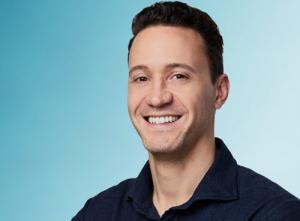Asset Risk and Worker Safety
Corey Capasso is the founder and CEO of Urbint.
Remember that movie about super-entrepreneur Mark Zuckerberg? Well those same folks might consider making a film about Corey Capasso and his inventions and building of businesses since the age of sixteen, when he became an online distributor of running shoes and then imported auto upholstery from Mexico, China, and Turkey throughout high school.

College only accelerated Corey's creativity. He started a student-to-student ticketing platform and then — no kidding — invented flavored plastic, patented in twenty-two countries no less. After graduating U of Wisconsin, Corey added athletic mouthguards to his creations and the resulting company has since grown into a major sporting goods manufacturer.
He then turned to analytics and founded a company with over a hundred and forty thousand sensors in retail locations worldwide. Our entrepreneur probably asked at that point, what next? And that is when Urbint was conceived — in 2015 — to apply advanced analytics and artificial intelligence to operators of infrastructure such as buildings and, then, utilities.
We recently talked with Corey about how utilities are leveraging the power of AI. It was a fascinating discussion as the following demonstrates. And it tempted us to be the ones to make that movie about him.
PUF's Steve Mitnick: You're the head of this super AI firm. What do you think are the most important applications for the utilities industry?
 Corey Capasso: You’re seeing safety incentives from the regulatory community with things like performance-based rates. You can use AI to hit some of those safety incentives, and to measure the reduction in certain types of risks.
Corey Capasso: You’re seeing safety incentives from the regulatory community with things like performance-based rates. You can use AI to hit some of those safety incentives, and to measure the reduction in certain types of risks.
Corey Capasso: From a technology perspective, one of the most important applications of AI would be in asset risk and worker safety, because at the end of the day the most important thing is making the system as safe as possible. We're leveraging AI to prevent worker accidents and incidents on job sites, as well as reducing critical infrastructure risks, which makes communities safer and more resilient.
PUF: How do you get all that data?
Corey Capasso: We're leveraging AI to find patterns that enable us to anticipate specific types of threats and likelihood of failure. The highest level of risk is always at the intersection of a utility's assets and some sort of external force, such as weather or construction.
To adequately predict asset-related threats, you need to know where the utility's assets are in the real world to start, which requires utility asset shapefiles in GIS. Then you need the historical records or data of whatever incident or outcome you're trying to predict. For example, if you're trying to predict where methane leaks are, you need inspection data from the utility of where they've been found in the past.
However, those datasets of assets, shapefiles, and historical records don't tell the full story, because they don't encompass all the external threats that lead to leaks such as pollution and soil conditions.
We then combine them with what we call Urbint's Model of the World. In a sense, Urbint has created a digital representation of every utility's service territory that captures all the types of external threats that could lead to certain types of risks - pollution, construction, soil conditions, weather - with hundreds of different types of features.
With the combined dataset that captures all the possible threats you could then apply to AI, to understand all the patterns, sequences, and combinations of events that lead to specific types of risks.
PUF: It's being used around the country. I know you're involved with a lot of companies.
Corey Capasso: That's correct. This isn't futuristic. This is technology currently adopted by more than forty major utilities today. On a daily basis they are able to maximize risk reduction for every dollar spent, increasing the safety of their communities that they serve.
PUF: Are companies - the utilities, and maybe the regulators - finding there are some impacts, like improved safety records, or impact on costs of service?
Corey Capasso: All our solutions enable utilities to quantify the risk reduction across different operational programs. In the case of excavation damage, for example, which is one of the number one causes of leaks, we're able to quantify a substantial reduction in third-party damages and damages per thousand tickets, which is the metric that utilities report to PHMSA every year.
For emergency response, which is one of our solutions where we're able to predict emergency call volume that a utility receives daily and weekly, we enable them to be more appropriately staffed and place folks in the field.
The metric we're measuring with the utility is response time, getting to wherever the call came from based on where the call is received. Reducing emergency response times not only improves safety and helps utilities meet industry expectations, but it also saves on OpEx because they're not overstaffed for fewer calls.
PUF: How did you come up with
the idea?
Corey Capasso: We started several years ago with the idea that we can model the real world, specifically buildings, and apply AI to it to predict when a building becomes distressed.
One of the biggest signs of distress in a building is when the building stops paying the electric bill. That led us to speaking to utilities to see if there was anywhere we could get electric usage data.
We couldn't, because utilities don't share their data. However, that led to an introductory conversation with Con Edison where we shared how we were making predictions about buildings
Con Edison looked at it and said, we like how you are using real world data and AI to make predictions about physical structures. We've got a gas pipe in every building. Can you change your prediction to predict whether that pipe has corrosion? The corrosion causes leaks, and today we inspect properties every three years. If you could tell us which properties are more likely to have corrosion, we could prioritize our inspections, so we could uncover higher risk assets faster.
Buildings were just one type of infrastructure and that was the lightbulb moment where we realized there was a massive opportunity to take our ability to model the real world and apply artificial intelligence and leverage that for infrastructure risk.
Think about how important that is. Modern day society as we know it is powered by utilities. Think about what we'd be doing while we're all working remotely without gas, electricity, water, and the internet. It wouldn't be possible.
PUF: Tell us about who works with you - the staff of your firm.
Corey Capasso: One of the biggest things that we had to do was build an incredible team, partly by pulling talent and skill sets from a lot of folks that came from outside the utilities industry, from industries that have faster adoption of cutting-edge technology.
We've assembled a team of over seventy-five folks from some of the best technology companies in the world. AI and machine learning have been more widely adopted by, for example, Fintech, and Adtech. You've got a lot of those companies in New York City.
We have folks from companies like Salesforce and Palantir, Flatiron Health, Yext, and AppNexus, which are some of the largest software companies in New York City and around the country.
PUF: Can this have a larger impact among utilities, maybe five, ten years from now?
Corey Capasso: Absolutely. We're at the tip of the iceberg, in terms of the safety impact AI can have on the utilities industry. There's so much. Utilities have to make decisions every day, while balancing safety, affordability, and reliability.
Then, if they can anticipate all of their threats in real time, it enables them to make more effective decisions, which will then lead to not only increased safety and more resiliency, but over time, will also reduce OpEx and make things more affordable and reliable.
PUF: What should our readers know about AI and what kind of questions should they ask, to be better informed and help this progress?
Corey Capasso: They should be more focused on technology specifically. Right now, for example, you're seeing a lot of safety incentives from the regulatory community, especially with things like performance-based rates.
That's great, because you can use technology and specifically, AI, to hit some of those safety incentives, and to measure the reduction in certain types of risks.
With the shifts in the regulatory community of taking more of a safety and risk-driven approach, that lends itself nicely to the utilities being able to adopt AI to help meet that shifting regulatory demand.
PUF: Some utility leaders are doing more in this area than others. What kind of questions do you get from companies that might be a little wary?
Corey Capasso: Generally, we've been pleased with the reception we've gotten from utility companies across the country. Since you've got aging infrastructure, changing weather, urbanization, and workforce turnover all happening at the same time, utilities realize that technology is going to play a critical role in helping them adapt to this new world. The operating environment has gotten too complex for them to keep doing things the same way.
The key thing that Urbint does is that all of these solutions quantify the safety impact on a particular operational program, which makes the value proposition clear in a way that utilities understand. All the KPIs we use are the existing KPIs that utilities use to measure their own performance.
PUF: You have this prominent role now in the industry on this important subject. What do you find most rewarding about what you're doing with this firm, and personally?
Corey Capasso: What motivates our team, is our mission, which is leveraging AI to enable utilities to make communities safer and more resilient, and the impact we are having across the country.
Our work directly impacts our employees, their friends, and their families. The problems we're solving are real and can't be ignored. That's the motivation.



